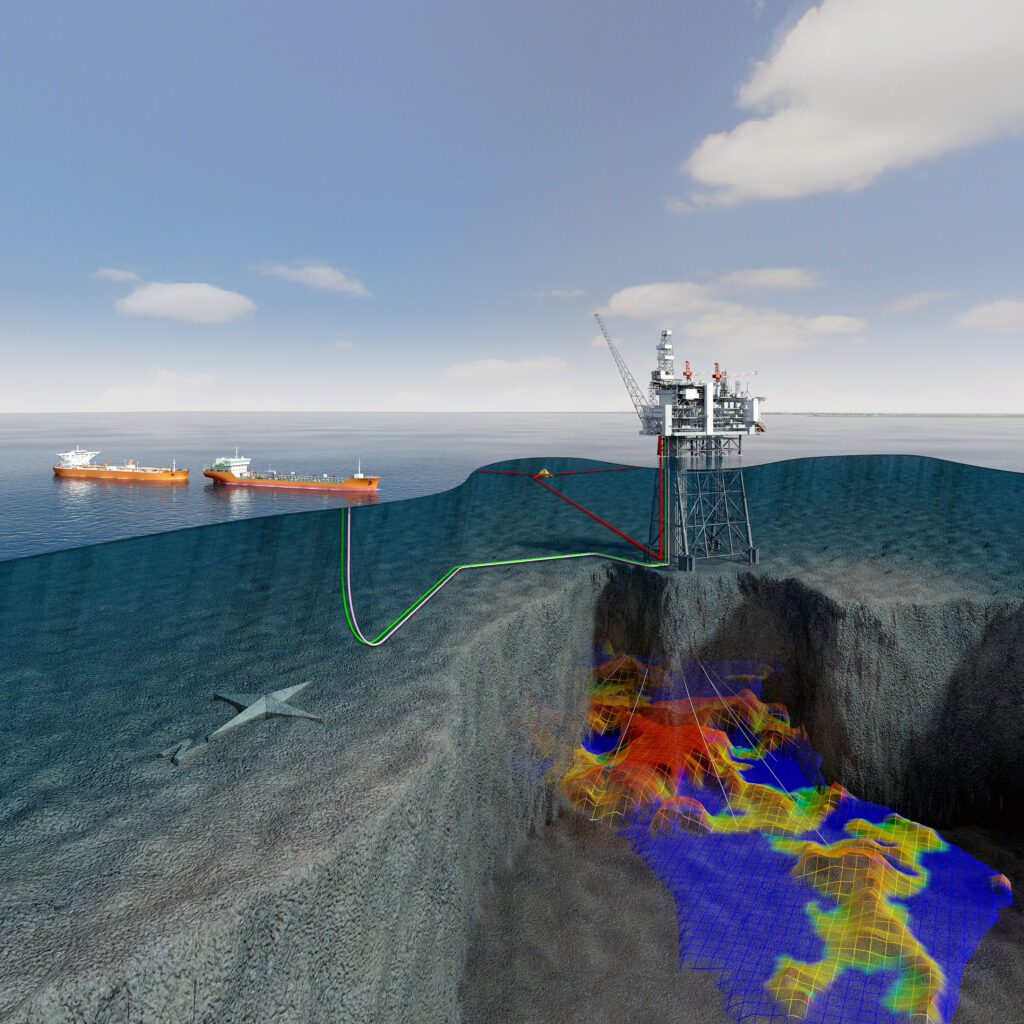Petroleum production in the UK

A Statoil UK subsidiary was established in London as early as the 1980s. This company pursued oil and gas trading internationally and concentrated on the British market for plastic raw materials.[REMOVE]Fotnote: Skorge, Wenche, “Statoil aktiv i London”, Statoil, no 3, 1987: 5. https://www.nb.no/industriminne/items/098ed849418f3a0b817f64cc0f26b290?page=3&searchText=London, accessed 1 June 2022.
But Statoil’s ambitions also extended to involvement on the UKCS. In 1985, it applied together with British Petroleum (BP) as operator and dominant partner for a block in the ninth licensing round.[REMOVE]Fotnote: “Statoil og BP søker sammen”, Status, no 1, 1985: 7.
London manager Peter J. Tronslin noted in 1987 that:
Many good reasons exist why Statoil is now making a full commitment to London and the UK. First, London is one of the world’s most important centres for crude oil trading. Second, Britain is Europe’s oldest and largest oil nation. It offers much outstanding technology, a lot to learn from and many interesting partners. Last but not least, Statoil wants to become an operator on the UKCS because Britain’s share of the North Sea still offers opportunities.”[REMOVE]Fotnote: Skorge, Wenche, op.cit: 5. At that time, the three big global centres for oil trading were London, New York and Tokyo.
Two years later, the company had landed its first operator assignment in block 22/1c as well as interests in six other blocks. Statoil UK then had 60-70 employees.[REMOVE]Fotnote: Hansen, Thorvald Buch, ”Gjennombrudd i Storbritannia. Statoil skal bore i britisk farvann”, Statoil Magasin, no 3, 1989: 37-38. https://www.nb.no/industriminne/items/b554878e5451d8756b12568d36993ace?page=35&subSite=statfjord&searchText=%22Statoil%20UK%22, accessed 1 June 2022.

The subsidiary’s workforce was up to more than 200 by 1997, when it produced 36 000 barrels of oil equivalent per day – a substantial increase from the early 1990s. An important reason for this growth was the acquisition of Aran Energy in 1995. Statoil also secured five UKCS operatorships and interests in four other licences in 1997.[REMOVE]Fotnote: Annual report, 1997, Statoil: 25; Annual report, 1995, Statoil: 23-24. (References to annual reports in this text refer to the Norwegian edition of the reports.) The Schiehallion field off Shetland contributed a further rise in output from 1998.
Mariner, Mariner East and Bressay

Statoil farmed into several oil discoveries on the UKCS in 2007, acquiring 44.4 per cent in Mariner, 60 per cent in Mariner East and 81.6 per cent in Bressay.[REMOVE]Fotnote: Annual report, 2007, StatoilHydro: 80. It also became operator for these finds, which lie not so far from Frigg to the west and south-west.
The company increased its Mariner stake in 2010 to 65.1 per cent.[REMOVE]Fotnote: Bjørheim, Camilla, “Statoil vokser på britisk sokkel”, Stavanger Aftenblad, 24 September 2010: 17. In December 2012, the decision was taken to spend NOK 39 billion on developing the field.[REMOVE]Fotnote: Stavanger Aftenblad, “Statoil bak største britiske felt på ti år”, 22 December 2012. It came on stream in August 2019.[REMOVE]Fotnote: Annual report, 2019, Equinor: 36.
Equinor farmed out of half its holding in Bressay, or 40.8 per cent, in 2020 to UK-based Enquest, which also took over as operator.[REMOVE]Fotnote: E24, “Equinor selger halvparten av britisk tungoljefelt”, https://e24.no/olje-og-energi/i/VbKXP4/equinor-selger-halvparten-av-britisk-tungoljefelt, accessed 8 June 2022.
Utgard and Barnacle
Production also began in September 2019 from the Utgard gas and condensate field, which straddles the UK-Norwegian median line in the North Sea. Equinor Energy is the operator, with 38 per cent of the field on the UKCS and 38.4 per cent of its Norwegian section. The first well was drilled in September 2018.[REMOVE]Fotnote: Annual report, 2021, Equinor: 44; Annual report, 2018, Equinor: 32. A 21-kilometre pipeline transports the gas and condensate to Norway’s Sleipner field,[REMOVE]Fotnote: Annual report, 2019, Equinor: 28. which operates the field remotely.[REMOVE]Fotnote: Ibid: 41.
Production started in December 2019 from the Barnacle oil field, operated by Equinor UK. Located close to the UK-Norwegian median line, it is tied back to Norway’s Statfjord B platform.[REMOVE]Fotnote: Annual report, 2021, Equinor: 44. For the operator status of Mariner, Utgard and Barnacle, see Annual report and form 20-F, 2021, Equinor: 42. The company has a 44.3 per cent holding in the field.[REMOVE]Fotnote: Annual report, 2019, Equinor: 41.
Rosebank
Located north-west of Shetland, the Rosebank oil discovery was made by Chevron in 2004. Statoil had a 30 per cent interest until it farmed out in 2013.[REMOVE]Fotnote: Annual report, 2009, Statoil: 57; Offshore Magazine, “Equinor to take control of Rosebank west of Shetland”, 1 October 2018, https://www.offshore-mag.com/field-development/article/16803568/equinor-to-take-control-of-rosebank-west-of-shetland, accessed 1 June 2022. Equinor acquired Chevron’s 40 per cent holding in 2018-19 and the operatorship.[REMOVE]Fotnote: Annual report, 2018, Equinor: 33 and 39. The aim was to use the experience gained by the company from such developments as Norway’s Johan Castberg field to increase Rosebank’s profitability.[REMOVE]Fotnote: Hovland, Ketil Malkenes, Equinors comeback på Rosebank-feltet: Vil “ta en Castberg”, E24, 27 October 2018, https://e24.no/boers-og-finans/i/A2152z/equinors-comeback-paa-rosebank-feltet-vil-ta-en-castberg, accessed 18 May 2022. The discovery is one of the largest on the UKCS still to be developed.
Equinor now has interests in several UK fields – Mariner, Utgard and Barnacle – which came on stream in 2019, as well as in Rosebank, a large undeveloped discovery. Time will tell how much relative weight these fossil fuel commitments will receive compared with the company’s commitment to offshore wind power on the UKCS.
arrow_backThe UK – not just any foreign countryWind power off the UKarrow_forward